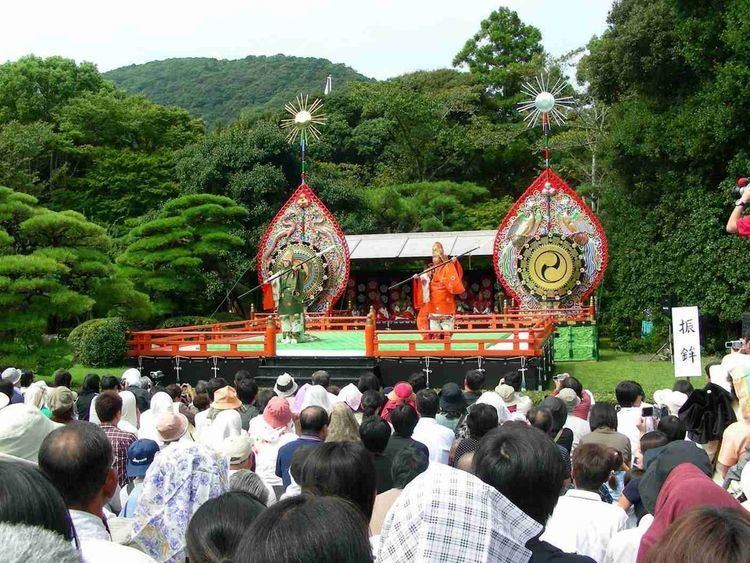 | ||
Gagaku (雅楽, gagaku, ancient imperial court music and dances, lit. "elegant music") is a type of Japanese classical music that has been performed at the Imperial Court in Kyoto for several centuries. This kind of music was first imported into Japan from China, however artistically it differs from the music of the corresponding Chinese form yayue which is a term reserved for ceremonial music. Gagaku consists of three primary repertoires:
Contents
- History of gagaku
- Instruments used in gagaku
- Wind
- String
- Percussion
- Influence on Western music
- Other cultural influence
- References
- Native Shinto religious music and folk songs and dance, called kuniburi no utamai
- A Goguryeo and Manchurian form, called komagaku (named after Goguryeo, which is pronounced Koma in Japanese, one of the Three Kingdoms)
- A Chinese and South Asian form (specifically Tang Dynasty), called Tōgaku.[1]
Gagaku, like shōmyō, employs the yo scale, a pentatonic scale with ascending intervals of two, three, two, two, and three semitones between the five scale tones.
History of gagaku
Gagaku, the oldest classical music in Japan, was introduced into Japan with Buddhism from China. In 589, Japanese official diplomatic delegations were sent to China (during the Sui dynasty) to learn Chinese culture, including Chinese court music, Gagaku. By the 7th century, the koto (a zither) and the biwa (a short-necked lute) had been introduced into Japan from China. Various instruments, including these two, were the earliest used to play gagaku.
Even though the Japanese use the same term 雅楽 (yǎyuè in Mandarin Chinese, ngahngohk in Cantonese), the form of music imported from China was primarily banquet music engaku rather than the ceremonial music of the Chinese yǎyuè. The importation of music peaked during the Tang Dynasty, and these pieces are called Tōgaku (Tang music). Gagaku pieces earlier than Tang Dynasty are called kogaku (ancient music), while those from after the Tang Dynasty are called shingaku (new music). The term gagaku itself was first recorded in 701, when the first imperial academy of music Gagakuryō was established.
Music from the Korean kingdom of Goguryeo, which is pronounced Koma in Japanese, had been recorded as early as 453 AD, and komagaku was eventually used as a term that covered all Korean pieces. Komagaku and Tōgaku became established in southern Japan during the Nara period (710-794). In 736, music from India and Indochina were also introduced and these are called Tenjikugaku and Rinyūgaku respectively. During the Heian period (794-1185), in the first half of the ninth century, gagaku music was reorganized and settled into the basic divisions of "music of the left" (primarily Tōgaku, now including Chinese, Indian and Japanese pieces) and "music of the right" (Komagaku, now music of Korea and Manchuria).
Gagaku reached a peak of popularity in the tenth century at court, but declined in the Kamakura period (1185-1333) when the power of the court aristocracy became diminished while that of the samurai rose. Gagaku was played by musicians who belonged to hereditary guilds. During the Kamakura period, military rule was imposed and gagaku was performed in the homes of the aristocracy, but rarely at court. At this time, there were three guilds, based in Osaka, Nara and Kyoto.
Because of the Ōnin War, a civil war from 1467 to 1477 during the Muromachi period, gagaku ensembles ceased to perform in Kyoto for about 100 years.
In the Edo period, the Tokugawa government revived and reorganized the court-style ensembles, the direct ancestors of the present gagaku ensembles.
After the Meiji Restoration of 1868, musicians from all three guilds came to the capital and their descendants make up most of the current Tokyo Imperial Palace Music Department. By that time, the present ensemble composition had been established, consisting of three wind instruments – hichiriki, ryūteki, and shō (bamboo mouth organ used to provide harmony) – and three percussion instruments – kakko (small drum), shōko (metal percussion), and taiko (drum) or dadaiko (large drum), supplemented by gakubiwa.
Gagaku also accompanies classical dance performances called bugaku (舞楽), and both are used in religious ceremonies by the Japanese new religion Tenrikyo and at a few Buddhist temples.
In 1955, the Japanese government recognized gagaku and bugaku as important National Treasures.
Today, gagaku is performed in two ways:
Komagaku survives only as bugaku.
Contemporary gagaku ensembles, such as Reigakusha (伶楽舎), perform contemporary compositions for gagaku instruments. This subgenre of contemporary works for gagaku instruments, which began in the 1960s, is called reigaku (伶楽). Twentieth-century composers such as Tōru Takemitsu have composed works for gagaku ensembles, as well as individual gagaku instruments.
Instruments used in gagaku
Wind, string and percussion instruments are essential elements of gagaku music.
Wind
String
Percussion
Influence on Western music
Beginning in the 20th century, several western classical composers became interested in gagaku, and composed works based on gagaku. Most notable among these are Henry Cowell (Ongaku, 1957), La Monte Young (numerous works of drone music, but especially Trio for Strings, 1958), Alan Hovhaness (numerous works), Olivier Messiaen (Sept haïkaï, 1962), Lou Harrison (Pacifika Rondo, 1963), Benjamin Britten (Curlew River, 1964), Bengt Hambraeus (Shogaku, from Tre Pezzi per Organo, 1967), Ákos Nagy Veiled wince flute quartet (2010), Jarosław Kapuściński (numerous works), and Sarah Peebles (numerous works).
One of the most important gagaku musicians of the 20th century, Masataro Togi (who served for many years as chief court musician), instructed American composers such as Alan Hovhaness and Richard Teitelbaum in the playing of gagaku instruments.
Other cultural influence
The American poet Steve Richmond developed a unique style based on the rhythms of gagaku. Richmond heard gagaku music on records at U.C.L.A.'s Department of Ethnomusicology in the early 1960s. In a 2009 interview with writer Ben Pleasants, Richmond claimed he had written an estimated 8,000-9,000 gagaku poems.
